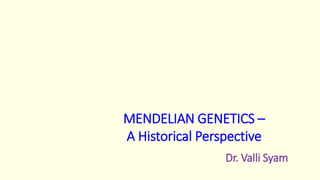
Mendelian Genetics - The Father of Genetics
- 1. MENDELIAN GENETICS – A Historical Perspective Dr. Valli Syam
- 2. Tries to explain the mechanism and the basis for similarities and differences between related individuals. Two aspects: Hereditary (inheritance) Variation Hereditary Process of transmission of characters in living beings from parents to offspring (ie one generation to next) Variation differences between individuals Because of variation, the brothers and sisters who resemble each other in many respects, are unique in certain feature Hereditary variation: Differences due to genetic or genic differences Environmental variation: Differences that arise due to environment ie. Due to food, temperature and other external features
- 3. JUPITER ACADEMY WWW.JUPITEREDUCATIONACADEMY.COM • Born on July 22, 1822 in Czechoslovakia • Attended courses in agriculture, pomiculture and viniculture (1840) • Entered Augustinian Monastery of St. Thomas at Brunn in Austria as Priest in 1847 • In 1851, sent to University of Vienna for training in Physics, Mathematics and Natural Sciences • Appointed as teacher in physics and Natural sciences in a secondary school Gregor Johann Mendel (1822 – 1884)
- 4. • Started experiments with pea plants in monastery garden – Continued for 9 years from 1856 to 1864 • Published his work in “The annual proceedings of Natural History Society of Brunn” 1865 • Made accurate predications based only on a few mathematical relationships, without the knowledge of nucleus, chromosomes, genes or DNA • Not recognized during his period • Rediscovered by three different scientists in three different corner of Europe – Hugo DeVries (Holland), Karl Correns (Germany) and Eric Von Tschermak (Austria)
- 5. Reasons for Obscurity of Mendel’s work • Journal in which he published was Obscure • Statistical methods are used for biological application at that time • Discouraged by Carl Von Naegeli and Anton Kerner • Preoccupied with Darwin’s theory of evolution “Origin of Species” • His work with other plants didn’t work out • Mendel – Constancy of characters of a species generation after generation – contrary to the Theory of Evolution – Required variations for natural selection to act upon • Mendel – Contrasting pairs of characters exhibiting discontinuous variation – Contemporaries were preoccupied with characters exhibiting continuous variations. • Phenomenon of fertilization and behaviour of chromosome during cell division were not known at the time of Mendel
- 6. Reasons for Mendel’s Success 1. Method of working • Analysis and proper planning • Studied only one character at a time • Carried out the experiments up to F2 and F3 generations • Maintained Statistical records of all the experiments and analysed them carefully • Selected genetically pure plants – purity was checked by self crossing the progeny for several generations • Crossing were done between the parents of pure lines having sharply visible contrasting characters • Grew different pure lines in separate garden plots, preventing the chances of their mingling
- 7. Reasons for Mendel’s Success 2. Selection of material Selection pea plant (Pisum sativum) for his work after long and careful thought - advantages • Annual Plant – Short Life cycle – possible to study several generations within a short period • Perfect Bisexual flowers – predominantly self pollinating • Because of self fertilization, plants are homozygous – easy to get pure lines for several generations • Easy to carry out Crossing breeding by controlled pollination
- 8. Reasons for Mendel’s Success 3. Selection of trait S.No. Character Trait Dominant Recessive 1 Stem Length Tall Dwarf/Short 2 Flower Position Axial Terminal 3 Flower Colour Purple White 4 Pod Shape Inflated Constricted 5 Pod Colour Green Yellow 6 Seed Shape Round Wrinkled 7 Seed Colour Yellow Green
- 9. Reasons for Mendel’s Success 4. Crossing Techniques • To prevent self fertilization, the anthers were removed from the plants (emasculation) taken as seed parent – even before the stigma was fully mature • The pollen from the pollen parent was dusted on the feathery stigma of emasculated or destaminised plants • Cross pollinated flowers were enclosed in separate bags to avoid further deposition of pollen from other sources • Seeds were collected separately in marked bottles. Seed character analysis – immediate – for other analyses – seeds were grown
- 10. Mendel’s Procedure Establishing pure line Crossing procedures Collection of Data Observations & Presentation Parental Generation Hybridization F1 Self fertilization of F1 F2 Monohybrids – one pair of contrasting character Dihybrids – Two pairs of contrasting characters Trihybrids – Three pairs of contrasting characters Polyhybrids – more than two pairs of contrasting characters
- 11. Mendel’s Observations • F1 showed only one trait – never the other • The trait which disappeared in F1 will reappear in F2 in the frequency of ¼ • The results of reciprocal crosses were the same
- 12. Mendel’s Hypotheses • Genetic characters are controlled by unit factors or determining agents which exist in pairs in individual organisms • When two unlike factors for a single character are present together in a single individual, one is dominant over the other which is said to be recessive • During gamete formation, these unit factors segregate independently and randomly. Each gamete will receive only one of the paired factor • During gamete formation, segregating pairs of unit factors assort independently of each other. Segregation of one pair – do not influence the segregation of other pair - seen in dihybrid and polyhybrids crosses
- 13. REFERENCES • Genetics – VB Rastogi – 4th Edition – Medtech Publishers -2019 • Cell Biology, Genetics, Molecular Biology, Evolution And Ecology - P.S. Verma &V.K. Agarwal - S. Chand & Company Ltd. 2005 • Genetics A conceptual approach – Benjamin A Pierce – W.H. Freeman & Company – 2012